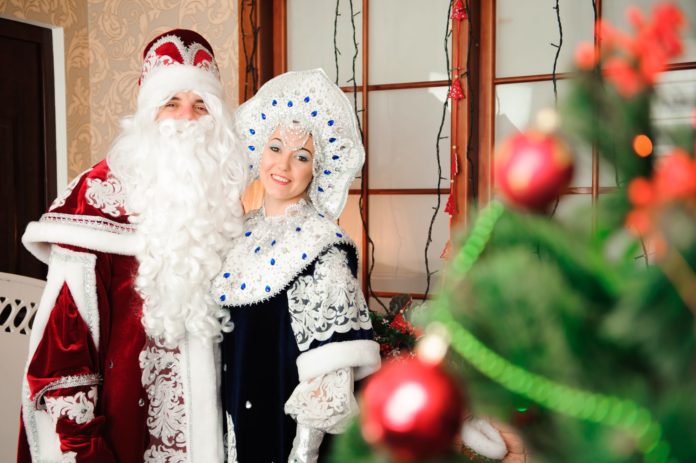Father Frost didn’t drop presents off for Russian children on Dec. 25. And he won’t on Orthodox Christmas (Jan. 7), either. Rather, Ded Moroz and his lovely snow maiden assistant, Snegurochka, are attached to New Year’s Eve, which in Russia is the new year and the secular bits of Christmas like trees and presents all rolled into one.
To understand how this came to be, we can’t just fly to modern-day Moscow. We begin, rather, over a thousand years ago.
Christmas became a religious holiday with the baptism of old Rus’, when Vladimir the Great accepted Christianity for himself and for his subjects as well. But Christmas has always come second to Easter in Orthodox Christianity, said Valentina Izmirlieva, a scholar of Balkan and Russian religious cultures at Columbia University.
New Year’s, meanwhile, only became a thing in Russia in 1700 when Peter the Great, westernizer that he was, accepted that, per the Gregorian calendar, Jan. 1 marked the New Year. But initially, Izmirlieva says, celebrations for the New Year were “kind of a modest thing.”
Gradually, Western Christmas elements started seeping into Russia – mostly from Germany, Russia’s principal port of call for Western culture. Some traditions, like the Christmas tree, took a while to catch on. Pine trees were, at the time, apparently considered a sign of death in Russia, and were not to be brought into one’s home.
In 1817, Tsar Nicholas I’s wife, a Prussian princess, brought a tree into her private quarters, death be damned. In the 1820s, there were gifts in the palace for the royal – and also impoverished – children. The presents were originally brought by St. Nicholas, but, by the late 19th century, came from Russian fairytale patriarch Father Frost. He’s a lot like old St. Nick, except he has a three horse carriage and is a bit less jolly. Later, beginning in the 1840s, it became more widespread; by mid-century, Russians began decking their halls – or at least their trees – with bows and lanterns.
By the turn of the century, the elements were falling into place. There was a decorated Christmas tree, a Santa-like figure and gift giving, and Christian reinterpretations of pagan traditions, such as divination. (That still lives on, in a way: today, some Russians write their new year’s wishes on a piece of paper, burn the paper, and then drink the ashes in champagne.) Then, in 1917, exactly 100 years after Princess Charlotte dared to bring in a pine tree, came the Russian Revolution, ushering in the explicitly secular Soviet era.
Initially, the Soviets tried to replace Christmas with a more appropriate komsomol (youth communist league) related holiday, but, shockingly, this did not take. And by 1928 they had banned Christmas entirely, and Dec. 25 was a normal working day.
Then, in 1935, Josef Stalin decided, between the great famine and the Great Terror, to return a celebratory tree to Soviet children. But Soviet leaders linked the tree not to religious Christmas celebrations, but to a secular new year, which, future-oriented as it was, matched up nicely with Soviet ideology.
Ded Moroz was brought back. He found a snow maid from folktales to provide his lovely assistant, Snegurochka. The blue, seven-pointed star that sat atop the imperial trees was replaced with a red, five-pointed star, like the one on Soviet insignia. It became a civic, celebratory holiday, one that was ritually emphasized by the ticking of the clock, champagne, the hymn of the Soviet Union, the exchange of gifts, and big parties.
Christmas itself was reinstated 25 years ago, in 1991. And it is indeed celebrated by religious (and even pseudo-religious) Russians. But the big celebrations are still reserved for New Year’s Eve.
“The New Year has become so ingrained in the society,” says Izmirlieva, “it is unifying.” Plus, “It’s for those who are not Christian, those who are anti-Christian, or members of other religions. It is still very strong.”
And so, in that strong spirit, our gift to you is this video of Russian singer Glukoza performing at New Year’s celebrations in 2009. The chorus roughly translates to, “Dance, Russia, while Europe weeps. And I have the absolute prettiest ass.”






